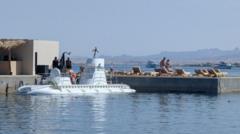The Sindbad submarine incident raises questions about safety standards and incident response in the tourist sector.
**Tragedy Strikes: Sindbad Submarine Sinks in Red Sea, Resulting in Fatalities**

**Tragedy Strikes: Sindbad Submarine Sinks in Red Sea, Resulting in Fatalities**
A tourist submarine tragedy claims six lives, including two children, leaving the community and authorities in shock.
The Red Sea off the coast of Egypt became the scene of a tragic accident early Thursday, as a tourist submarine, named Sindbad, sank, leading to the death of six passengers, all of whom were from Russia. The incident occurred near Hurghada, a popular tourist destination, and involved 45 individuals onboard, including tourists from India, Norway, Sweden, and five Egyptian crew members. Authorities reported that among those rescued, nine sustained injuries, four of which are critical.
Local governor, Amr Hanafy, confirmed the sad news, detailing that the six deceased included two children and two married doctors. The Russian Embassy in Egypt initially indicated that all passengers were Russian nationals, stirring further mourning in their home country.
The Sindbad submarine had operated for several years, offering picturesque underwater explorations of coral reefs. The submarine's operations are run by Sindbad Submarines, claiming to possess two of only 14 real recreational submarines worldwide, each accommodating 44 passengers. Passengers typically enjoy tours that delve 25 meters underwater, with safety briefings provided in multiple languages.
Passenger accounts vary regarding safety experiences aboard these submarines. Dr. James Aldridge described a well-organized trip, noting the absence of overcrowding and feeling safe overall. In contrast, Benjamin Grey raised concerns after noticing the vessel surfacing multiple times during his trip, indicating anomalies in the operation, including perceived safety communication lapses.
The submarine sank approximately one kilometer from the coast, around 10:00 AM local time. Given the area's popularity among tourists, mishaps involving vessels are not unprecedented. In November, for example, another tourist boat sank, resulting in the deaths of 11 individuals, prompting questions about the safety protocols in place within the tourist boating industry.
Egyptian authorities are currently investigating the sinking's cause while navigating the murky waters of accountability and safety protocols. Early assessments suggest the submarine had the necessary licensing and that conditions were calm at the time of sinking. With this recent incident, the spotlight is again turned to the safety measures employed by tourist operators in the competitive and often dangerous arena of adventure tourism in the Red Sea.
Local governor, Amr Hanafy, confirmed the sad news, detailing that the six deceased included two children and two married doctors. The Russian Embassy in Egypt initially indicated that all passengers were Russian nationals, stirring further mourning in their home country.
The Sindbad submarine had operated for several years, offering picturesque underwater explorations of coral reefs. The submarine's operations are run by Sindbad Submarines, claiming to possess two of only 14 real recreational submarines worldwide, each accommodating 44 passengers. Passengers typically enjoy tours that delve 25 meters underwater, with safety briefings provided in multiple languages.
Passenger accounts vary regarding safety experiences aboard these submarines. Dr. James Aldridge described a well-organized trip, noting the absence of overcrowding and feeling safe overall. In contrast, Benjamin Grey raised concerns after noticing the vessel surfacing multiple times during his trip, indicating anomalies in the operation, including perceived safety communication lapses.
The submarine sank approximately one kilometer from the coast, around 10:00 AM local time. Given the area's popularity among tourists, mishaps involving vessels are not unprecedented. In November, for example, another tourist boat sank, resulting in the deaths of 11 individuals, prompting questions about the safety protocols in place within the tourist boating industry.
Egyptian authorities are currently investigating the sinking's cause while navigating the murky waters of accountability and safety protocols. Early assessments suggest the submarine had the necessary licensing and that conditions were calm at the time of sinking. With this recent incident, the spotlight is again turned to the safety measures employed by tourist operators in the competitive and often dangerous arena of adventure tourism in the Red Sea.



















